Subaru B9-Tribeca Navigation-System 2006 Owner's Manual

Contents
Safety Warnings....................................................................... |
5 |
Before Use ................................................................................ |
6 |
System Components and Controls...................................... |
10 |
Starting Up the Navigation System .................................... |
12 |
Language Selection ............................................................... |
14 |
Markers and Controls Displayed on Maps.......................... |
15 |
Screens During Route Setting ...................................................... |
15 |
Screens During Route Guidance .................................................. |
17 |
Menu Screen Keys and Functions........................................ |
18 |
Map Operations ..................................................................... |
20 |
Selecting Map Orientation ............................................................ |
20 |
Changing Map Scale ...................................................................... |
21 |
Setting Route ......................................................................... |
23 |
Setting Destination ........................................................................ |
23 |
Setting destination/waypoints by scrolling the map ........................................ |
23 |
■ Selecting route .......................................................................................... |
25 |
Setting the destination from the navigation menu .......................................... |
26 |
■ “Address” method .................................................................................. |
28 |
■ “Memory Point” method .......................................................................... |
31 |
■ “Home” method or method using stored destinations ............................ |
33 |
■ “Point of Interest” method ...................................................................... |
34 |
■ “Previous Destination” method ................................................................ |
36 |
■ “Select from Map” method ...................................................................... |
37 |
■ “Freeway Entrance/Exit” method ............................................................ |
38 |
■ “Emergency” method .............................................................................. |
40 |
■ “Coordinates” method .............................................................................. |
42 |
■ “Intersection” method .............................................................................. |
44 |
■ “Phone number” method.......................................................................... |
46 |
■ Using “Change Search Area” function .................................................. |
48 |
Route Guidance ..................................................................... |
49 |
Route Guidance Screen.................................................................. |
49 |
Zoom-in Map at Intersection ........................................................ |
50 |
Dual Map Display............................................................................ |
51 |
Freeway Information ...................................................................... |
52 |
Replaying Voice Guidance ............................................................ |
52 |
Route Options ........................................................................ |
53 |
Setting Route Options .................................................................... |
53 |
Search condition .............................................................................................. |
55 |
Detour .............................................................................................................. |
56 |
Route preferences............................................................................................ |
57 |
Destination and waypoints .............................................................................. |
58 |
■ Addition of waypoints .............................................................................. |
58 |
■ Modifying destination or waypoint positions ............................................ |
60 |
■ Modifying visiting order ............................................................................ |
62 |
■ Deleting destination or waypoints ............................................................ |
64 |
■ Deleting destination and all waypoints...................................................... |
65 |
Display route .................................................................................................... |
66 |
Route preview .................................................................................................. |
67 |
■ Setting conditions for simulation drive ...................................................... |
68 |
Navigation Setup................................................................... |
70 |
Setting Your Navigation System .................................................. |
70 |
User settings .................................................................................................... |
72 |
Quick POI selection.......................................................................................... |
75 |
Volume.............................................................................................................. |
77 |
Navigation information .................................................................................... |
78 |
■ Vehicle signal ............................................................................................ |
78 |
■ Version ...................................................................................................... |
79 |
Calibration ........................................................................................................ |
80 |
■ Adjusting current position and direction.................................................... |
80 |
■ Distance .................................................................................................... |
82 |
Set clock .......................................................................................................... |
83 |
Restore system defaults .................................................................................. |
84 |
3

Contents |
|
Stored Locations.................................................................... |
86 |
Memory points ................................................................................................ |
89 |
■ Storing new memory points ...................................................................... |
89 |
■ Reviewing and modifying memory points ................................................ |
91 |
■ Deleting memory points ............................................................................ |
94 |
■ Deleting all memory points........................................................................ |
95 |
■ Modifying category names ........................................................................ |
96 |
Avoid area ........................................................................................................ |
97 |
■ Storing avoid areas .................................................................................... |
97 |
■ Reviewing and modifying avoid areas ...................................................... |
99 |
Home.............................................................................................................. |
100 |
■ Storing home .......................................................................................... |
100 |
Previous destination (deleting stored locations) ............................................ |
102 |
Preset destinations ........................................................................................ |
104 |
■ Storing preset destinations...................................................................... |
104 |
■ Reviewing and modifying preset destinations ........................................ |
106 |
Other Functions ................................................................... |
108 |
Displaying POIs on a map .............................................................................. |
108 |
■ Local search ............................................................................................ |
109 |
Displaying POI data ........................................................................................ |
111 |
Deleting POI markers .................................................................................... |
112 |
General Information ............................................................ |
113 |
■ Accuracy of vehicle position .................................................................. |
113 |
■ How the vehicle position is detected .................................................... |
114 |
■ Accuracy of the route guidance .............................................................. |
115 |
When a Problem Occurs .............................................................. |
116 |
4

Safety Warnings
You will find a number of WARNINGs, CAUTIONs and NOTEs in this supplement.
These safety warnings alert you to potential hazards that could result in injury to you or others.
Please read these safety warnings as well as all other portions of this supplement carefully in order to gain a better understanding of how to use your Navigation system safely.
WARNING
A WARNING indicates a situation in which serious injury or death could result if the warning is ignored.
CAUTION
A CAUTION indicates a situation in which injury or damage to your vehicle including Navigation system, or both, could result if the caution is ignored.
NOTE
A NOTE gives informaton or suggestions how to make better use of your Navigation system.
5

Before Use
WARNING
READ THIS MANUAL FIRST
Read this supplement carefully before using your navigation system. We are not liable for accidents or other problems resulting from failure to follow the instructions in this supplement.
OBEY LOCAL ROAD SIGNS AND REGULATIONS
Always obey local road signs and regulations while following instructions given by the navigation system. Some of the data on the DVD-ROM disc may be outdated due to changes in local road signs and regulations. Furthermore, the data on the DVD-ROM disc does not take into account variable factors such as the weather, road congestion at different times of the day, temporary road closures due to road construction, and special events. Local road signs and regulations always take precedence over directions given by the system.
Failure to obey them could place you in physical danger or in violation of the law.
DRIVE SAFELY
•Before following an instruction (for example, in the case of changing direction) given by the system, check that the action would be safe to take in the current traffic conditions. Continue to pay attention to safety while following any instruction.
•Do not be distracted by the navigation screen. Failure to keep your attention on the road could lead to an accident. When you need to look at the screen while driving, do so for the shortest time possible and avoid staring at the screen.
•You must stop the vehicle in a safe place before operating the navigation system. For safety’s sake, some of the navigation system’s controls and functions cannot be used unless the vehicle is stationary.
•Use this system only in locations where it is legal to do so. Some states/provinces may have laws prohibiting video screens within sight of the driver.
VOLUME LEVEL
Keep the system’s volume level low enough for you to be able to hear outside sounds while driving. To do otherwise may prevent you from reacting appropriately to traffic conditions and could result in an accident.
6
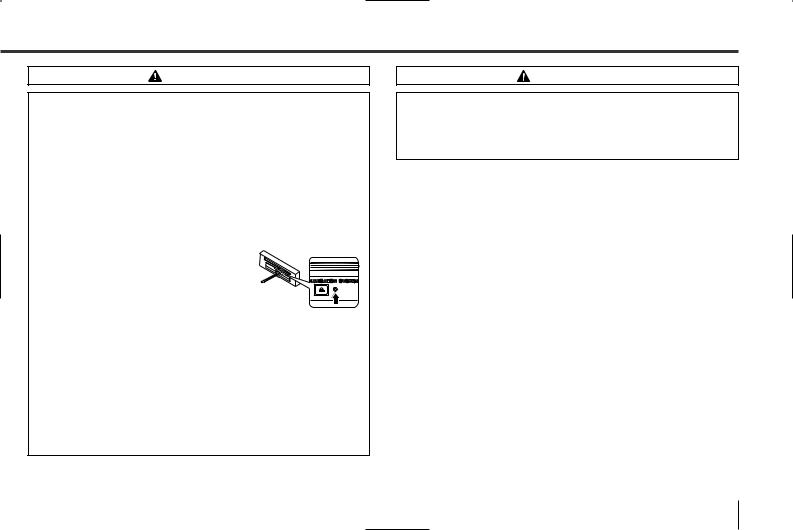
Before Use
CAUTION
FOREIGN OBJECTS
Do not allow foreign objects to enter the disc insertion slot, including your fingers.
Foreign objects inside the system’s main unit could cause an electric shock or a fire. If the main unit emits smoke or an unusual smell, stop using the system immediately and you contact the nearest SUBARU dealer.
STOP OPERATION IN THE EVENT OF A PROBLEM
In the event of a problem such as
the absence of sound or video, try pressing the reset button. Should the problem persist, stop using the system and you contact the nearest
SUBARU dealer.
(The reset button is also used when you need to upgrade the program. Insert an upgrade disc and press the reset button.)
NEVER DISASSEMBLE OR MODIFY THE SYSTEM
Any attempt to disassemble or modify any part of the system could lead to an electric shock or a fire, or some other type of accident.
CAUTION
The displays contain mercury. Therefore, the displays must be removed before vehicle disposal. Once the displays have been removed, please reuse, recycle or dispose of them as hazardous waste.
7

Before Use
■ Points to note before use
Starting the engine before using the system
The navigation system can be used with the ignition key in either the ON position or the ACC position. To preserve the battery, however, it should be used with the engine running whenever possible. Using the system for a long time with the engine off can cause the battery to run down.
Delay before display of current position
The system will not immediately display a correct indication of your vehicle’s current position after being switched on for the first time or after the battery has been disconnected for a long time. It will display a correct current position indication as soon as it receives Global Positioning System (GPS) signals.
Program reloading after battery disconnection
The navigation program will be erased from the system’s memory if the battery is disconnected. If this happens, load the provided DVD-ROM disc in the system’s main unit and turn the ignition switch to the ON or ACC position. The system will automatically reload the program and start operating normally again.
Incorrect operation on rough roads
The system may operate incorrectly or be unable to read the data on the DVD-ROM disc when subjected to severe vibration caused by driving on rough roads.
Handling the GPS antenna
Do not paint the antenna. Doing so could impair or prevent signal reception.
Disabled switches
Some switches are disabled during operation of the system. These switches are displayed in fainter colors and no messages are displayed for them.
Risk of damage to the main unit
Be mindful of the occupant compartment temperature. Using the system when the occupant compartment temperature is extremely high or low can damage it or cause it to malfunction. Also, note that the system’s main unit can be damaged by strong vibration and by any metallic object or water that gets inside.
Condensation
Condensation can form on the lens inside the main unit when there is a rapid change in occupant compartment temperature (for example, when the heater is switched on in cold weather). Such condensation can cause the system to operate abnormally. If you wait an hour or so for the condensation to disappear, the system should start working normally again. If normal operation is still not restored after several hours, we recommend that you contact the nearest SUBARU dealer.
8

Before Use
Replacing the DVD-ROM disc
If you need to replace the DVD-ROM disc, make sure the replacement disc is compatible with your system’s main unit. Inserting an incompatible disc could damage the unit.
■Handling precautions for DVD-ROM discs
•Handle DVD-ROM discs carefully. Any DVD-ROM disc with excessive warping or scratches on its surface can cause reading errors.
•Store DVD-ROM discs away from direct sunlight, which can cause warping and render them unusable.
•DVD-ROM discs rotate at high speeds inside the system’s main unit. Never use a cracked or badly warped disc; doing so could damage the unit.
•To clean a DVD-ROM disc, lightly wipe it with a soft cloth in straight lines from the center hole toward the outer edge.
•Never clean DVD-ROM discs with benzene, thinner, record spray, antistatic spray, or chemical swabs.
•Do not touch the DVD-ROM disc’s data surface (the surface without a printed label). A dirty data surface can cause reading errors. Always hold a DVD-ROM disc by the center hole and at one point on the outer edge, or by two points on the outer edge.
•Do not write anything on DVD-ROM discs or affix anything, such as stickers, to them.
9
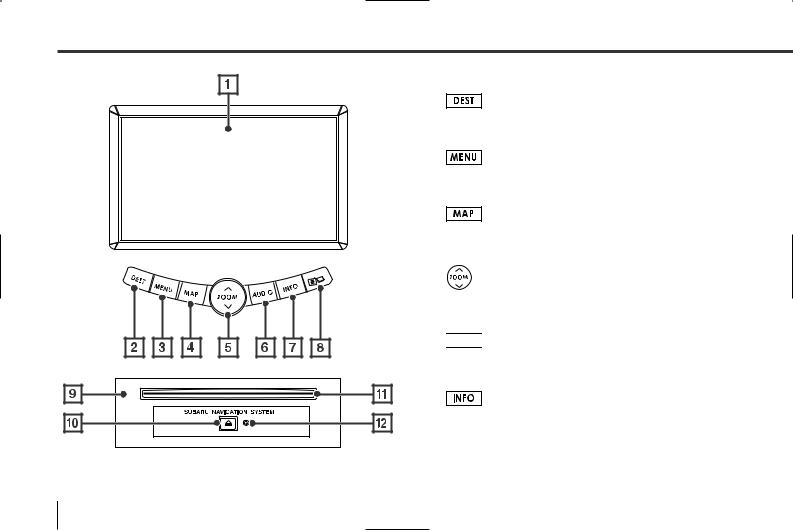
System Components and Controls
1 Monitor
2
This button is used to display the destination entry screen of the navigation system.
3
This button is used to display the menu screen of the navigation system.
4
This button is used to switch to the navigation system’s current map screen from any other screen.
5
This button is used to zoom out or zoom in the map displayed on the screen.
6 

This button is used to display the Audio or RSE (Rear Seat Entertainment) screen.
7
This button is used to display the vehicle information screen. Refer to the Owner’s Manual Supplement for Monitor System for further details.
10

System Components and Controls
8
This button is used to adjust the brightness and contrast of the screen image as well as to display a calendar. Refer to the Owner’s Manual Supplement for Monitor System for further details.
9 Navigation system main unit
pEject button
Depressing this button ejects the DVD-ROM disc.
qDisc insertion slot
Load a DVD-ROM disc into the system’s main unit through this slot. Inserting an edge of the disc in the slot causes it to be drawn in automatically.
wReset button
You can use this button in the event of a problem. It is also used when you need to upgrade the program.
NOTE
•The navigation system main unit is located under the driver's seat.
•Before you load a DVD-ROM disc for the first time, press the reset button for more than one second. Use the tip of a pen or similar item for this purpose.
•If a malfunction occurs during operation, try pressing the reset button. The system may recover from the problem.
11
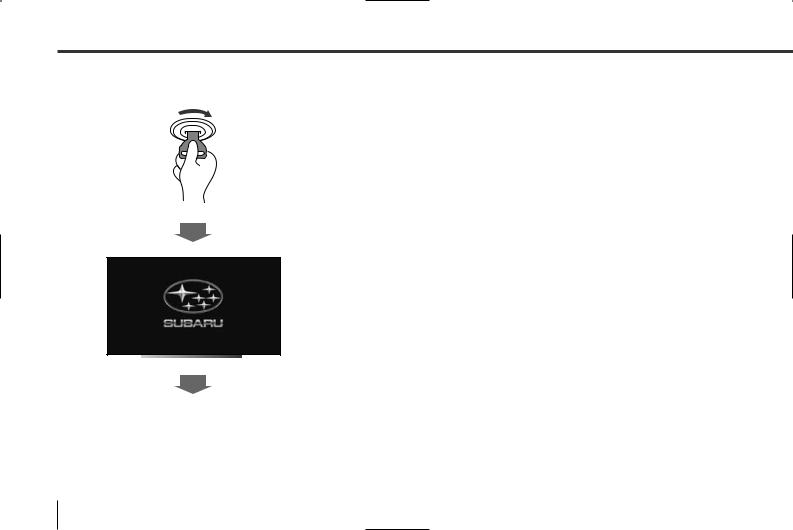
Starting Up the Navigation System
Use the following procedure to start up the navigation system and display the current map screen.
1 |
Start the engine. |
|
The CAUTION screen will appear, followed by the opening screen. |
||
|
12
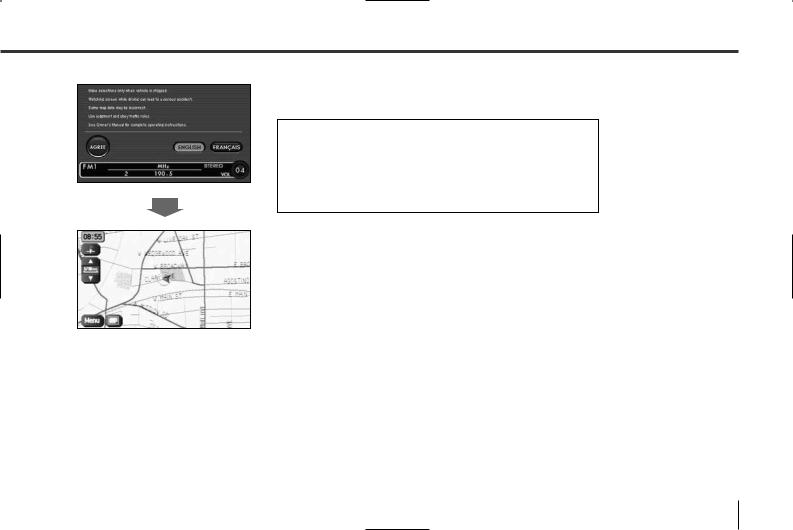
Starting Up the Navigation System
NOTE
Carefully read the instructions on the CAUTION screen (cited below), then select  .
.
CAUTION
Make selections only when vehicle is stopped.
Watching screen while driving can lead to a serious accident.
Some map data may be incorrect.
Use judgment and obey traffic rules.
See Owner’s Manual for complete operating instructions.
The current map screen will appear.
•To make a selection, touch the desired key displayed on the screen.
•The CAUTION screen remains on the display unless you select  .
.
•When you use the navigation system for the first time, Greenwich Mean Time will be displayed. Adjust the system’s clock to the right time using the clock setting screen (“SET CLOCK”) as described on Page 83.
13
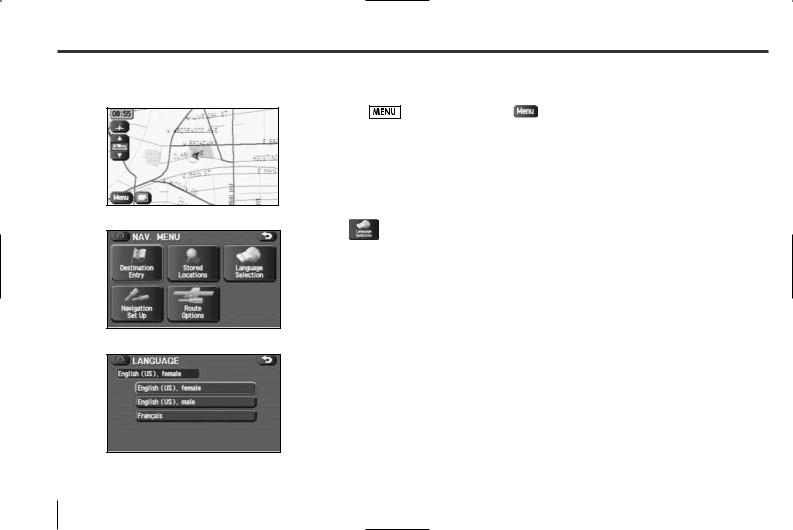
Language Selection
Use the following procedure to select your preferred language for the menu screens and the voice guidance.
1 |
Press the |
button or select |
on the current map screen. |
|
|
|
2 |
Select |
(Language Selection). |
|
|
3 |
Select your preferred language from the list. |
|
14
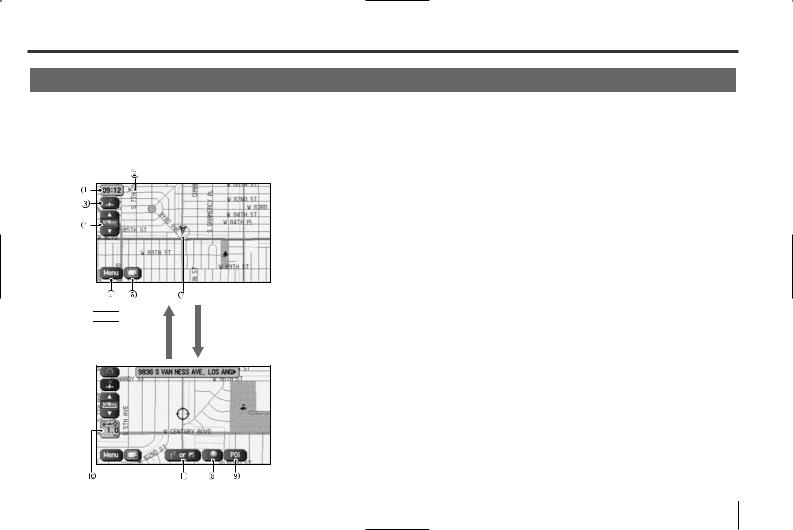
Markers and Controls Displayed on Maps
Screens During Route Setting
Touch a point on the map. A crosshair (scroll mark) will appear on the screen. Then touch a desired point on the map. The map will scroll with the selected point at the center.
<Current Position screen>
Press 


 button
button
or select  to return Scroll the map to the current map
to return Scroll the map to the current map
screen.
<Scroll screen>
1Time
Indicates the current time.
2GPS marker
Shows the status of the signal from GPS satellites. When this marker appears, your navigation system is receiving GPS signals and using them to calculate the position of your vehicle.
3Map orientation control
Used to select either a “north up” display or “heading up” display of the map. (See Page 20.)
4Zoom-out/zoom-in control and map scale
The up-pointing or down-pointing arrow is used to zoom out
or zoom in the map. The number indicates the scale of the
displayed map. The  button also provides the zooming function.
button also provides the zooming function.
5Menu control
Select this key to display the menu screen. (See Page 18.)
6Screen configuration control
Allows you to select a preferred display type for route guidance. (See Page 49.)
7Vehicle marker
Indicates the current position and direction of your vehicle.
15

Markers and Controls Displayed on Maps
8“Store memory point” key
Stores markers on the map.
This key appears just for a few seconds after a map screen is selected.
9Point of interest (POI) key
Allows you to display the POI selection screen (see Page 108). On the screen, you can program POIs to appear on a map as markers. This key appears just for a few seconds after a map screen is selected.
0Distance from current position
Indicates the distance from the current position to the position marked by 

 .
.
-Destination/waypoint key
Used to program a destination or waypoint at the position marked by 

 on a scroll screen.
on a scroll screen.
16
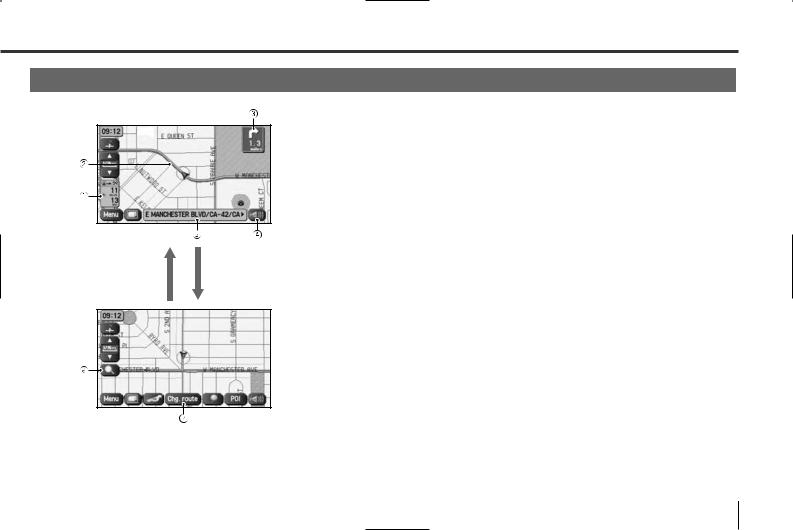
Markers and Controls Displayed on Maps
Screens During Route Guidance
(5 seconds) |
Select the screen |
1Distance and time to destination
Indicates the time (either approximate time required or time of arrival) and the distance to the destination or a waypoint.
2Route
A thick green line indicates the route you should follow.
3Turn guidance arrow
Indicates the direction of your turn at the next intersection/junction as well as the distance to the intersection/junction.
4“Repeat voice” key
If this key is selected, the last voice guidance will be repeated.
5Current road name
Shows the name of the road you are currently driving on.
6“Display whole route” key
If this key is selected, a map containing the entire route will be displayed. (See Page 66.)
7“Change route” key
Selecting this key displays the route option menu. Selecting a new route option causes the system to calculate the selected route.
17

Menu Screen Keys and Functions
<Current map screen> |
<Menu screen> |
Press 


 button or select
button or select  to display the menu screen.
to display the menu screen.
Select  to return to the current map screen.
to return to the current map screen.
The table below shows the keys displayed on the navigation menu (NAV. MENU) screen, the functions accessible by selecting these keys, and the pages of this manual that describe the instructions you should follow when using these functions.
18
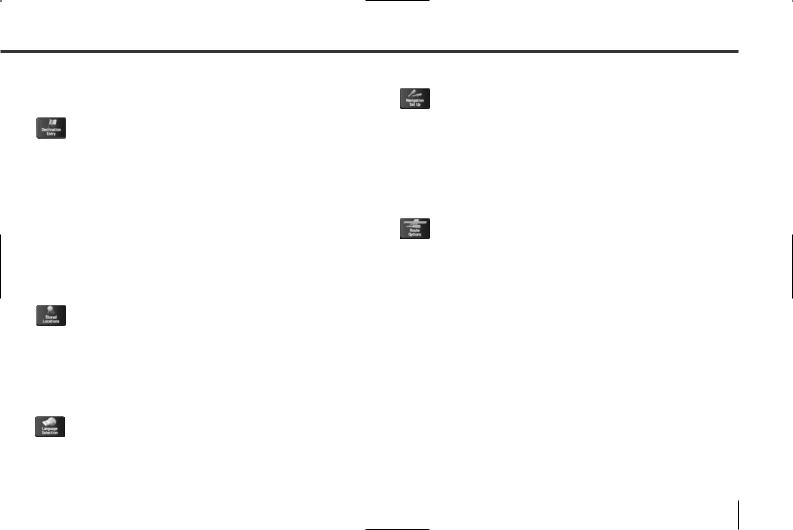
Menu Screen Keys and Functions
Menu screen key |
Function |
Reference |
|
|
page |
Destination Entry |
Address |
page 28 |
|
|
|
|
Point of Interest |
page 34 |
|
Select from Map |
page 37 |
|
|
|
|
Emergency |
page 40 |
|
|
|
|
Memory Point |
page 31 |
|
Previous Destination |
page 36 |
|
|
|
|
Intersection |
page 44 |
|
|
|
|
Freeway Ent/Exit |
page 38 |
|
Phone Number |
page 46 |
|
|
|
|
Coordinates |
page 42 |
Stored Locations |
Memory Points |
page 89 |
|
Avoid Area |
page 97 |
|
|
|
|
Dest. & Way Pt. |
page 58 |
|
|
|
|
Home |
page 100 |
|
Previous Dest. |
page 102 |
|
|
|
|
Preset Dests. |
page 104 |
Language Selection |
Language Selection |
page 14 |
|
|
|
Navigation Set Up |
User Settings |
page 72 |
|
|
|
|
Quick POI Selection |
page 75 |
|
|
|
|
Volume |
page 77 |
|
Navigation Information |
page 78 |
|
|
|
|
Calibration |
page 80 |
|
|
|
|
Set Clock |
page 83 |
|
Restore System Defaults |
page 84 |
Route Options |
Search Condition |
page 55 |
|
|
|
|
Detour |
page 56 |
|
Route Pref. |
page 57 |
|
|
|
|
Dest. & Way Pt. |
page 58 |
|
|
|
|
Display Route |
page 66 |
|
Route Preview |
page 67 |
19

Map Operations
Selecting Map Orientation
You can select either “heading up” or “north up” display on the current map screen by using the following procedure.
1 |
Select or . |
|
<“Heading up” display>
If you select  (“heading up” display), the system rotates the map so that the direction in which you are heading is always directly upwards on the screen (the red arrow points to the north).
(“heading up” display), the system rotates the map so that the direction in which you are heading is always directly upwards on the screen (the red arrow points to the north).
<“North up” display>
If you select  (“north up” display), the system rotates the map so that north is always directly upwards on the screen.
(“north up” display), the system rotates the map so that north is always directly upwards on the screen.
20

Map Operations
Changing Map Scale
You can increase or decrease the scale of the map using the following procedure:
1 |
Select |
or |
to change the map scale. |
|
The |
button also allows you to change the map scale. |
|||
|
||||
Selecting  or
or  (or operating the
(or operating the  button) changes the scale as shown to the left.
button) changes the scale as shown to the left.
21
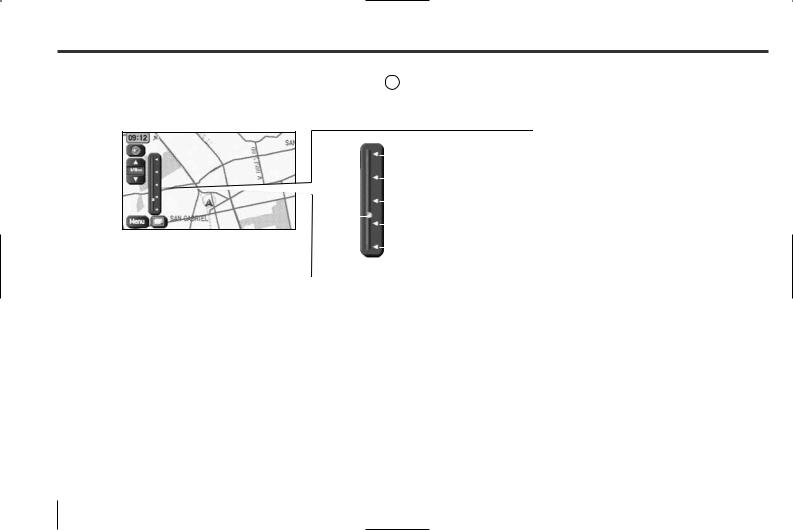
Map Operations
NOTE
•You can keep selecting  or
or  (or operating the
(or operating the 
 button) to continually change the map scale.
button) to continually change the map scale.
•If you touch an appropriate point on the right side of the scale bar after selecting  or
or  (operating the
(operating the  button), you can choose directly from any of the five scales.
button), you can choose directly from any of the five scales.
|
|
|
|
Imperial display |
Metric display |
|
|
|
|
128 mi (mile) |
256 Km |
|
|
|
|
||
|
|
|
|
16 mi (mile) |
32 Km |
|
|
|
|
||
Position |
|
|
|
2 mi (mile) |
4 Km |
|
|
|
|||
|
|
|
|
|
|
before |
|
|
|
|
|
change |
|
|
|
1/4 mi (mile) |
500 m |
|
|
|
|
||
|
|
|
|
1/32 mi (mile) |
50 m |
|
|
|
|
||
|
<Scale bar> |
|
|||
• The scale can be displayed in Imperial or metric units. To change the units, see Page 72.
22

Setting Route
Setting Destination
Setting destination/waypoints by scrolling the map
Even if you do not know the exact address of your destination or a waypoint on your route to the destination, you can set it by scrolling the map as follows:
1 |
Touch the screen and scroll the map until the crosshair |
reaches the |
destination or a waypoint. |
|
|
|
|
2 |
|
Select the |
(destination or waypoint) key. |
|
The key will separate into the destination key and the waypoint key. |
||
|
|
||
|
|
|
|
23

Setting Route
3
4
Select  for setting the destination.
for setting the destination.
The system will calculate the route and display the entire route to the destination on the map.
Select  for a waypoint. The system will program the address of the waypoint on your route (see Page 86). You can set up to 5 waypoints per trip.
for a waypoint. The system will program the address of the waypoint on your route (see Page 86). You can set up to 5 waypoints per trip.
Select  (start).
(start).
Route guidance will begin along the displayed route.
NOTE
•If the system cannot find your desired route, select  (change route). This will allow you to access the ROUTE OPTIONS screen, from which you can prompt the system to calculate a new route. (See Page 53.)
(change route). This will allow you to access the ROUTE OPTIONS screen, from which you can prompt the system to calculate a new route. (See Page 53.)
•Selecting  for more than ten seconds will start the demonstration mode operation. Press the
for more than ten seconds will start the demonstration mode operation. Press the 


 button or select
button or select  to cancel the demonstration mode.
to cancel the demonstration mode.
24
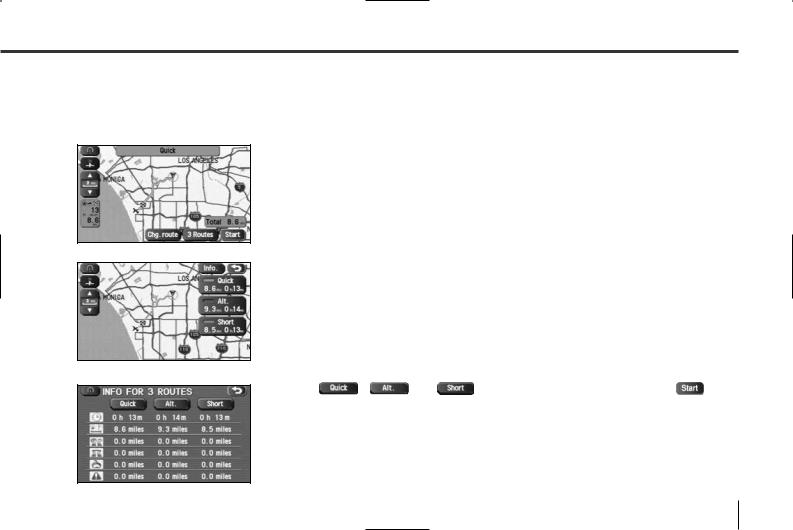
Setting Route
■ Selecting route
Upon setting the destination, the system prepares to calculate three types of routes to the destination (Quick, Alt., and Short). You can select from any of the three options as follows:
1
2
Select  (3 routes).
(3 routes).
The system will be ready for calculation of any route you select from the three options, namely, Quick (the fastest route), Alt. (alternative route), and Short (the shortest route).
Select  (information).
(information).
The screen will display details (required time, total distance, roads used, etc.) regarding each option.
3 |
Select |
, |
, or |
as you desire, and then select |
to |
confirm your selection. |
|
|
|||
|
|
|
|||
25

Setting Route
Setting the destination from the navigation menu
You can set your destination using a variety of methods if you start setting from the navigation menu screen. Before you can use any of these methods, perform the following steps:
1
2
Press the 


 button or select
button or select  .
.
Press the 


 button or select
button or select  (destination entry).
(destination entry).
26
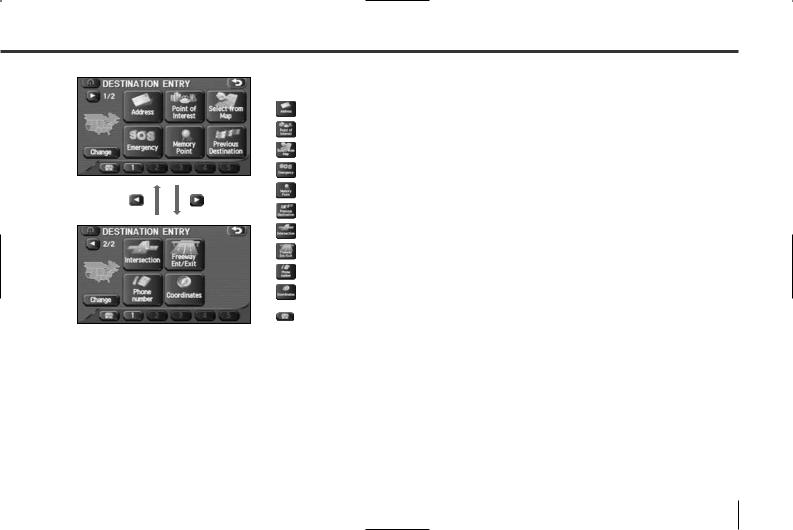
Setting Route
3
NOTE
Select the method you want to use.
(Address)* |
See Page 28. |
(Point of Interest)* |
See Page 34. |
(Select from Map) |
See Page 37. |
(Emergency) |
See Page 40. |
(Memory Point) |
See Page 31. |
(Previous Destination) |
See Page 36. |
(Intersection)* |
See Page 44. |
(Freeway Ent/Exit) |
See Page 38. |
(Phone number) |
See Page 46. |
(Coordinates) |
See Page 42. |
(Home) |
See Page 33. |
You can switch between screens by selecting  (next page) or
(next page) or  (previous page).
(previous page).
•If the set destination area is different from the one displayed under “Search Area” in the right part of the screen, you must
 (change) key and specify the desired area again.
(change) key and specify the desired area again.
•For the methods marked with an asterisk ( * ), you can use the “Change Search Area” function to narrow the area where a destination or waypoint is located by selecting the  (change) key (see Page 48).
(change) key (see Page 48).
•Depending on the method used or the status of the map displayed, the located point may differ from where the facility you want to visit actually exists.
27
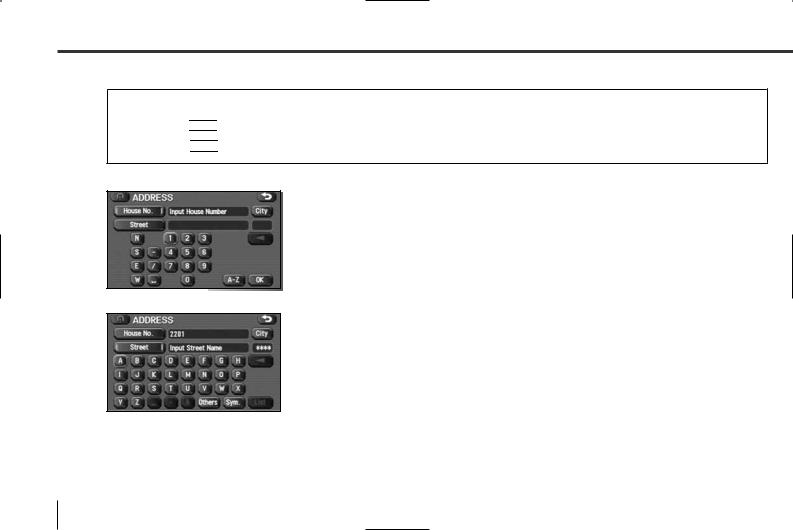
Setting Route
■ “Address” method
1
2
First, choose either of the two procedures below to follow the “address” method.
• Press the 


 button or select
button or select  , select
, select  (destination entry), and then select
(destination entry), and then select  (address).
(address).
• Press the 


 button and select
button and select  (address).
(address).
Enter a house number using the keypad on the house number input screen and select  .
.
Enter the street name.
If you enter enough letters to identify a street name and advance to Step 3, a list showing several street names will be displayed. Select the desired street name from the list.
 : Use this key to delete the last character entered. Select it repeatedly if you want to delete all the characters entered.
: Use this key to delete the last character entered. Select it repeatedly if you want to delete all the characters entered.
You can switch between keypad screens showing different characters by selecting  (others),
(others),  (symbols) or
(symbols) or  (alphabet).
(alphabet).
28
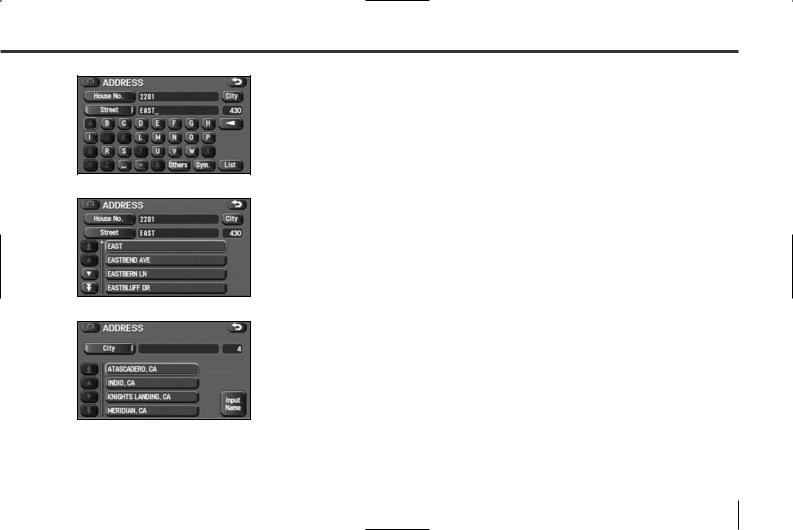
3
4
5
Setting Route
Select  (list).
(list).
Select the desired street from the list.
If the same street name exists in more than one city, a list of these cities will be shown.
Select the correct city from the list.
 : Use this key to input the city name from the keypad.
: Use this key to input the city name from the keypad.
29

Setting Route
6 |
|
Select |
(destination) to set the address entered in the above steps |
|
as your final destination. |
||
|
|
||
|
|
The system will calculate the route and display the entire route on the map. |
|
|
|
Select |
(waypoint) to set the address entered in the above steps as a waypoint |
|
|
on your route. |
|
7 |
|
You can program up to five waypoints per trip. |
|
|
|||
|
Select |
(start). |
|
|
Route guidance begins along the displayed route. |
||
|
|
||
NOTE
•If the system cannot find your desired route, select  (change route). This will allow you to access the ROUTE OPTIONS screen, from which you can prompt the system to calculate a new route. (See Page 53.)
(change route). This will allow you to access the ROUTE OPTIONS screen, from which you can prompt the system to calculate a new route. (See Page 53.)
•If your DVD-ROM disc does not contain the relevant house number data, an error message will be displayed and a street map will appear, allowing you to set the destination using the map.
•If your destination is not on a road, set a destination point on a main road nearest to your true destination.
•Selecting the  will display a screen that searches the destination on a city basis.
will display a screen that searches the destination on a city basis.
 : Search the destination from all cities.
: Search the destination from all cities.
 : Search the destination from the nearby five cities within 20 miles from the current position.
: Search the destination from the nearby five cities within 20 miles from the current position.
 : Search the destination by inputting the city name.
: Search the destination by inputting the city name.
You can also search the destination from the five cities that you searched in the past.
30
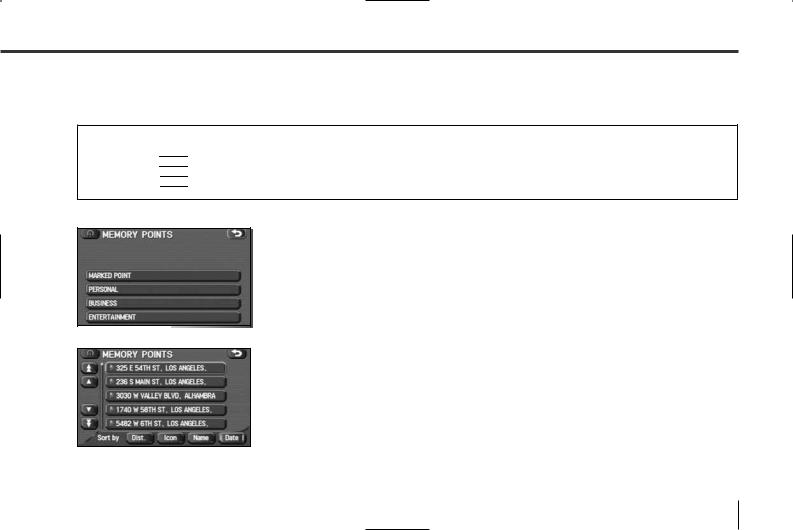
Setting Route
■ “Memory Point” method
If you have saved some locations in the system’s memory, you can make use of an appropriate one to set the destination.
1
2
First, choose either of the two procedures below to follow the “memory point” method.
• Press the 


 button or select
button or select  , select
, select  (destination entry), and then select
(destination entry), and then select  (memory point).
(memory point).
• Press the 


 button and select
button and select  (memory point).
(memory point).
Select the category to which the address of the desired location (memory point) is classified in the memory.
Select the address of the desired location (memory point).
 : Use this key to display up to five previous suggestions.
: Use this key to display up to five previous suggestions.
 : Use this key to display the previous suggestion.
: Use this key to display the previous suggestion.
 : Use this key to display the next suggestion.
: Use this key to display the next suggestion.
 : Use this key to display up to five of the next suggestions.
: Use this key to display up to five of the next suggestions.
31

Setting Route
3 |
Select |
(destination) or |
(waypoint). |
|
|
|
NOTE
•Select the  (destination),
(destination),  (icon),
(icon),  (name), or
(name), or  (date) key to change the sequence in which memory points are displayed.
(date) key to change the sequence in which memory points are displayed.
•You cannot use the “Memory Point” method unless there are memory points stored. To store memory points, see Page 89.
32
